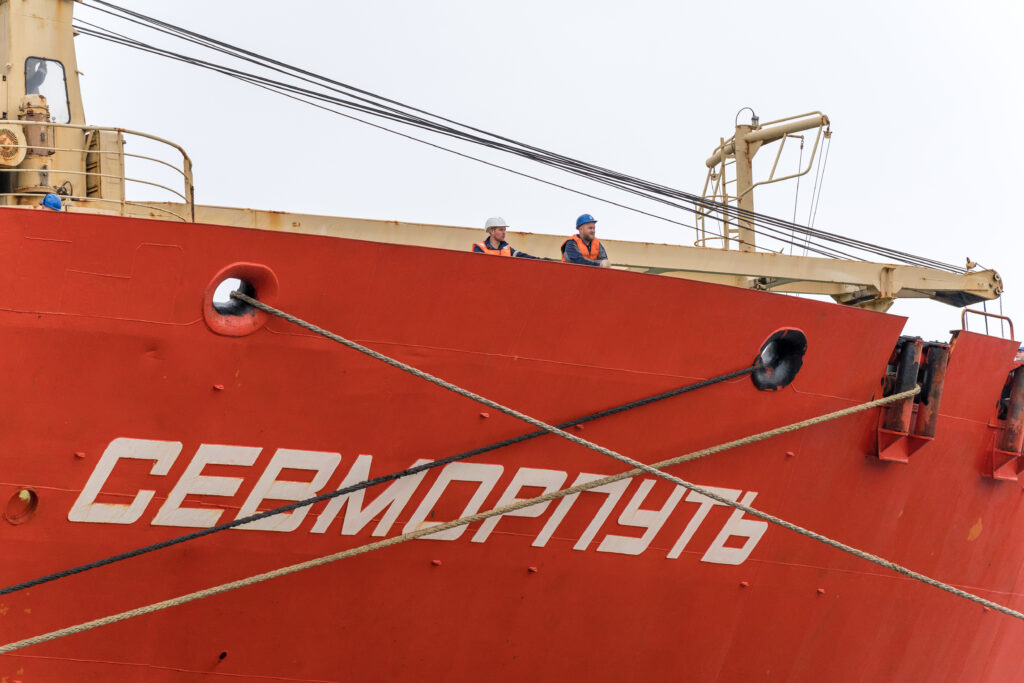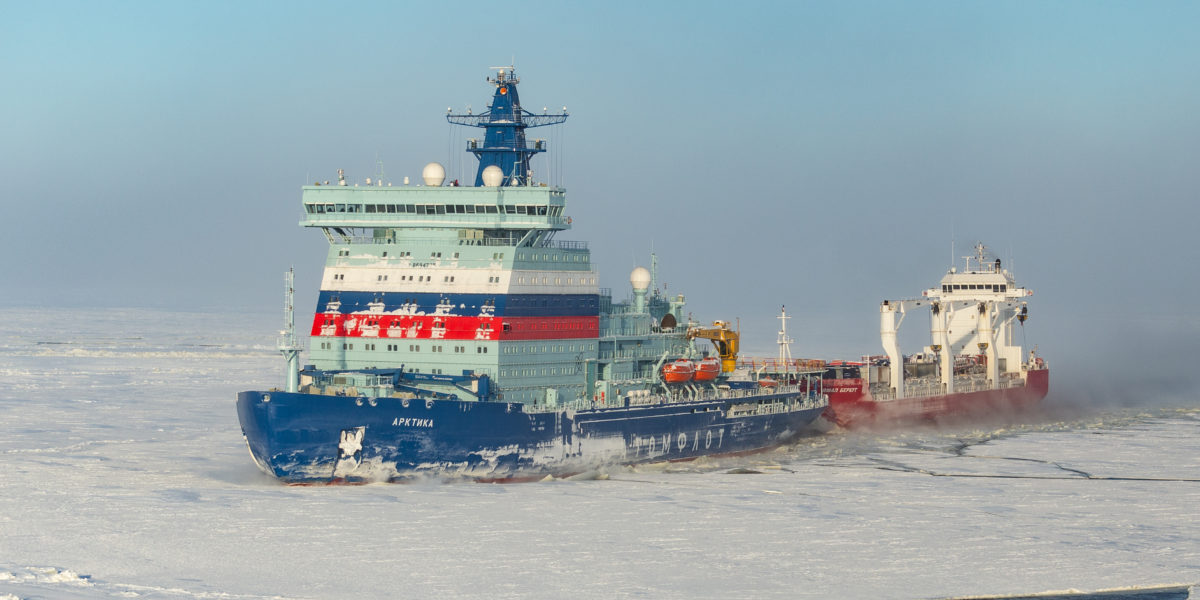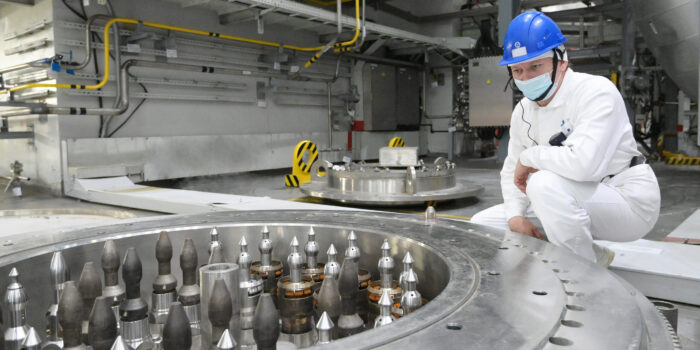Key events in 2023 and early 2024:
- Rosatomflot and Baltic Shipyard JSC entered into a contract for the construction of the fifth and sixth serial universal nuclear icebreakers (SUNI) of Project 22220 – February 2023.
- A contract has been signed for the construction of a nuclear service vessel (Automatic Service Vessel) for new generation nuclear icebreakers – May 2023.
- An agreement was signed on the construction of the world’s first nuclear power plant with a capacity of up to 10 MW in Chukotka – June 2023.
- Supply of nuclear fuel for replacement at the world’s first floating nuclear power plant “Akademik Lomonosov” – October 2023.
- The start of work on the first nuclear fuel reloading in the history of the station at a floating nuclear power plant – November 2023.
- Shipment of the first RITM-200 reactor for SUNI Chukotka – October 17, 2023. Delivery of the reactor to Baltic Shipyard JSC – October 30.
- The floating nuclear power plant has supplied about 722 million kWh of electricity to the network of the Chaun-Bilibino energy hub (Chukotka Autonomous Okrug) since its connection to the network – December 19, 2023.
- Shipment of the second RITM-200 reactor for SUNI Chukotka is December 2023. Delivery of the reactor to Baltic Shipyard JSC – December 22, 2023.
- Launch of spacecraft of the Arktika-M series, designed to survey the Arctic region of the Earth – December 2023.
- The volume of cargo transported along the NSR in 2023 amounted to 36.254 million tons – December 2023.
- Laying down of the 5th SUNI “Leningrad” – January 2024.
- Concern Rosenergoatom (the electric power division of the State Corporation Rosatom) officially received the status of operating organization of low-power nuclear power plants (LNP) in the Republic of Sakha (Yakutia) – February 2024.
NSR. General Information

The Northern Sea Route (NSR) is the shortest shipping route between the western part of Eurasia and the Asia-Pacific region. Administratively, the Northern Sea Route begins at the boundary between the Barents and Kara Seas (the Kara Strait) and ends in the Bering Strait (Cape Dezhnev). The route is 5.6 thousand km long. The NSR straddles the seas of the Arctic Ocean (Kara, Laptev, East Siberian, and Chukchi Seas).
The NSR serves the ports located in the Artic and on large Siberian rivers. There are currently six major seaports located on the NSR route in the Arctic Zone of the Russian Federation: Sabetta, Dikson, Dudinka, Khatanga, Tiksi, and Pevek ports.
The seas of the Arctic Ocean are covered with ice for most of the year. Icebreaker escorting is organized to ensure safe navigation along the NSR. Russia is the only country in the world with a nuclear icebreaker fleet. The fleet operator is the Rosatom State Corporation enterprise FSUE Atomflot.
In 2018, Rosatom was designated the infrastructure operator of the NSR.
The NSR development plan up until 2035, in terms of Rosatom’s responsibility, provides for the creation of the necessary infrastructure: from the construction of icebreaking and hydrographic vessels to the creation of ports and digital services to improve navigation efficiency.
In order to ensure sustainable and environmentally responsible navigation on the NSR, starting from 2021, on the initiative of Rosatom, the Marine Research Center of M. V. Lomonosov Moscow State University (MSU MRC) launched a pilot research program on environmental monitoring of the NSR, taking into account advanced Russian and international requirements and practices in the field of environmental research and protection, and the development of a program for regular monitoring of the NSR water area.
In 2023, a detailed multi-level system of environmental monitoring measures was developed and presented. The created program was supported by an International Group of Experts (IGE), which monitored the progress of the project. This program will be used to solve environmental problems in the development of the NSR as a single infrastructure project.
Freight traffic along the Northern Sea Route (NSR) in 2023 exceeded the target of the federal project “Development of the Northern Sea Route,” supervised by the Rosatom State Corporation, by more than 250 thousand tons. The volume of cargo transported along the NSR in 2023 amounted to 36.254 million tons.
Cargo traffic on the NSR is growing rapidly: 2012 – 3.87 million tons, 2013 – 3.93 million tons, 2014 – 3.982 million tons, 2015 – 5.392 million tons, 2016 – 7.265 million tons, 2017 – 10.7 million tons, 2018 – 19.7 million tons, 2019 – 31.5 million tons, 2020 – 32.978 million tons, 2021 – 34.867 million tons, 2022 – 34.117 million tons, 2023 – 36.254 million tons.
In 2023, the record for transit traffic in the waters of the Northern Sea Route was broken; more than 2.1 million tons of cargo were transported. Before this, the record figure was 2021, when 2 million tons were transported in transit.
Decree of the Government of the Russian Federation No. 2115-r of August 1, 2022 approved a new Plan for the Development of the Northern Sea Route for the period up to 2035 (hereinafter referred to as the Plan). Rosatom is a party in charge for the majority of the activities under the Plan which are structured in the following areas: development of the freight base, transport infrastructure, cargo and icebreaker fleet, safety of navigation on the NSR, navigation management and development on the NSR.

The first target for the development of the Northern Sea Route is to increase cargo flow along NSR. A powerful Arctic nuclear icebreaker fleet is needed to attain this figure.
Rosatom is pursuing this objective in two areas: extending the life of existing icebreakers and upgrading the icebreaker fleet.
To date, there are seven nuclear icebreakers in the icebreaking fleet of FSUE Atomflot: 50 let Pobedy, Vaigach, Yamal, Taimyr, Arktika serial universal nuclear icebreaker (SUNI) (project 22220), Sibir SUNI (project 22220), Ural SUNI (project 22220), as well as nuclear container ship Sevmorput. The operational period of the icebreakers Yamal, Vaygach and Taimyr has been extended to 36 years and ends in 2027–2028. This will make it possible to carry out the necessary scope of work on the NSR before the commissioning of new nuclear-powered vessels.
Under construction are:
- Yakutia SUNI (project 22220) with a capacity of 60 MW, scheduled to be commissioned in 2024, ice class – Icebreaker 9, construction at the shipyard of Baltic Shipyard JSC, launched in 2022;
- Chukotka SUNI (project 22220) with a capacity of 60 MW, scheduled to be commissioned in 2026, ice class – Icebreaker 9, construction at the shipyard of Baltic Shipyard JSC.
- Lead icebreaker Rossiya (project 10510 Leader) with a capacity of 120 MW, scheduled to be commissioned in 2027, ice class – Icebreaker 9, construction at the shipyard of Zvezda SSK LLC.
In February 2023, a contract was signed for the construction of the 5th and 6th SUNIs of project 22220 with the participation of federal budget funds, the commissioning of which is planned in 2028 and 2030, respectively:
- 5th SUNI (project 22220) with a capacity of 60 MW. The laying took place in January 2024. Commissioning is scheduled for December 2028. Ice class – Icebreaker 9, construction at the shipyard of Baltic Shipyard JSC.
- 6th SUNI (project 22220) with a capacity of 60 MW. Keel laying is scheduled for the fall of 2025. Commissioning is scheduled for December 2030. Ice class – Icebreaker 9, construction at the shipyard of Baltic Shipyard JSC.
In May 2023, Rosatomflot and Baltic Shipyard JSC (part of the United Shipbuilding Corporation) have signed a contract for the construction of a nuclear maintenance vessel (NMV) for new generation nuclear icebreakers. The projected commissioning date is 2029.
The NMV is designed to carry out operations for unloading spent nuclear fuel from reactor installations of serviced vessels; loading fresh nuclear fuel; receiving, storing and shipping liquid radioactive waste generated during the operation of ship reactor installations, as well as during the refueling; storage of spent fuel assemblies to reduce residual heat. It can also load cooled spent fuel assemblies into packaging sets for transfer to processing and decontamination of removable equipment of ship reactor installations and refueling equipment. The NMV is therefore designed to perform a full range of operations on recharging nuclear power plants of existing nuclear icebreakers, as well as the Akademik Lomonosov FNPP.
Design characteristics of the NMV: length – 158.8 m, width – 26 m; draft – 7.5 m; power plant power – 9.28 MW (on shafts); displacement – 22,661 tons; speed – 12 knots; ice class – Arc5.
It is also planned to build a hydrographic fleet vessel with an Arc7 ice class.
Rosatom is discussing with interested users of the NSR the construction of four additional non-nuclear icebreakers of Icebreaker 8-9th class, for extra-budgetary funds to operate near ports and terminals of the Western part of the NSR and at the mouth of the Yenisei River, which will free up more powerful and autonomous nuclear icebreakers of the above projects to work in the Eastern sector of the NSR. The construction of these icebreakers is planned in the period from 2023 to 2030.
The second objective is to create a new port infrastructure and modernize the existing one. It is implemented in the context of major investment projects, in particular: the project Terminal of Liquefied Natural Gas and Stable Gas Condensate Utrenniy, the project Oil Terminal Port Bay North, the project Construction of the Water Area of a Cargo Berth and Canal of an Offshore Coal Terminal on the basis of the Syradasayskoye field, the project Construction of a Marine Terminal on Cape Nagleynin in the seaport of Pevek.
The third objective is to ensure the compliance of the service on the NSR with the level of international standards of merchant shipping to attract transit traffic. Rosatom is implementing a number of important measures for the development of transport infrastructure, the Arctic cargo and icebreaking fleet, the creation of Arctic shipbuilding facilities, and hydrographic support.
The fourth objective is to introduce new small and medium-sized power capacities, including mobile ones, for the development of the Arctic and port facilities in the NSR waters.
As part of this objective, Rosatom supplies power for the future mining and processing plant in Chukotka.

Logistics
The implementation of the Euro-Asian Container Transit (EACT) project to create a regular container line for transit cargo transportation between the eastern and western parts of Eurasia through the NSR is carried out by Rosatom Logistics LLC, an enterprise of the Rosatom State Corporation.
The EACT project is aimed at creating a regular container line for transit cargo transportation between the eastern and western parts of Eurasia via the Northern Sea Route (NSR). The EACT project is being implemented in accordance with the NSR Development Plan for the period until 2035, approved by the Government of the Russian Federation on August 1, 2022.
As a result of the implementation of the EACT project, it is planned to launch a year-round, fast, reliable and economically competitive cargo delivery service between the eastern and western parts of Eurasia, which will complement the existing transport routes and will contribute to enhancing the stability of global supply chains and the development of the “blue economy”. Among the obvious advantages of the EACT are a shorter route length and greater cargo security due to transit within the territorial waters of one country and the absence of piracy risks.
Rosatom and DP World (Dubai, UAE), one of the world’s leading supply chain integrators, have signed an agreement on strategic cooperation for the development of Eurasian logistics and container transportation along the Northern Sea Route (NSR). One of the areas of this cooperation is the creation of a joint venture for the development of the EACT project. In October 2023 Rosatom and DP World created a joint venture, LLC International Container Logistics, to develop transit container transportation along the Northern Sea Route.
At the pilot stage of the project, it is planned to build up to nine high ice class container ships, as well as two logistics hubs in the Murmansk Region (Western LH, WLH) and the Primorye Territory (Eastern LH, ELH). The LHs will be used for cargo transshipment from specialized ice-class container ships to non-ice-class vessels for subsequent delivery of containers to the target ports of Eurasia.
Each LH will be furnished with advanced high-performance equipment and consist of two deep-water berths designed to receive vessels with a capacity of up to 6 thousand TEUs. The estimated capacity of each terminal will be about 10 million tons per year.
Currently, the Western Logistics Hub is under design, and preparations are underway for the start of the design of the Eastern Logistics Hub, container ships, the amount of investments and the work schedule are being ascertained, the development of the concept of digitalization of the port and ship infrastructure of the EACT project is underway. The pilot operation of the service will begin after 2027.
The EACT project will make a significant contribution to the development of the Arctic region and the global “blue economy”: it will improve the stability of global supply chains, create additional jobs, increase the GDP of the Arctic regions of the Russian Federation, as well as give impetus to the development of related industries and raise the level of environmental safety.





